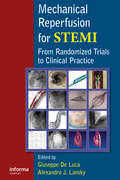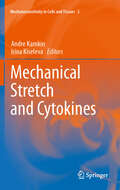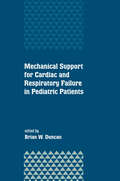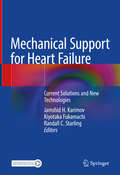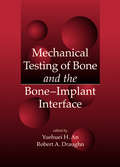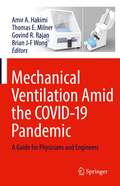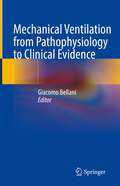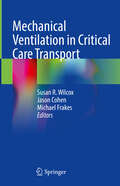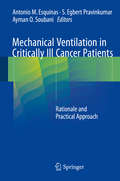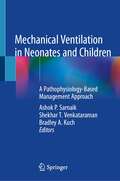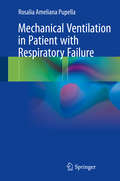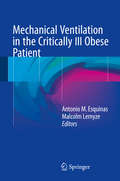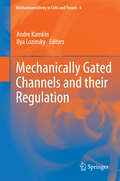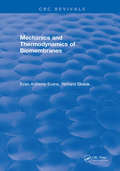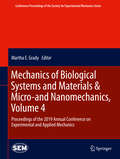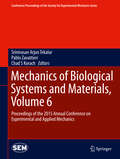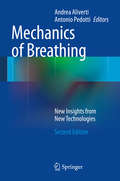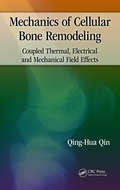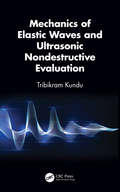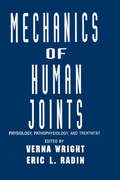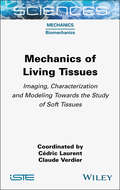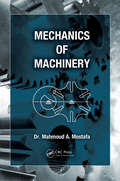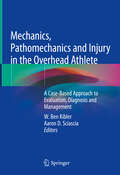- Table View
- List View
Mechanical Reperfusion for STEMI: From Randomized Trials to Clinical Practice
by Giuseppe De Luca Alexandra J. LanskyAs a leading cause of death in developed countries, ST-segment elevation myocardial infarction and its various treatment options are of great concern to those in the cardiology field. This text presents evidence-based chapters that supply clinicians with real-life situations and strategies to treat STEMI patients more effectively and at a quicker p
Mechanical Stretch and Cytokines
by Irina Kiseleva Andre KamkinThis book presents the latest findings in the field of investigation of molecular mechanisms of mechanical stretch and the role of cytokines in response of different tissues to it. On the one hand this Volume demonstrates how mechanical stretch enhances cytokines production. It describes how cytokines influence tissues and cells on a background of a mechanical stretching. It provides a description of how cells in different tissues are activated by stretch and cytokines via various signaling pathways, and how they change their gene expression. The book is a unique collection of reviews outlining current knowledge and future developments in this rapidly growing field. Knowledge of biomechanics, and mechanisms which underlie it on molecular, cellular and tissue, is necessary for understanding of the normal functioning of living organisms and allows to predict changes, which arise due to alterations of their environment.
Mechanical Support for Cardiac and Respiratory Failure in Pediatric Patients
by Brian DuncanAnswering the demand for acomprehensive, all-purpose volume focusing on the challenging needs of pediatric patients, Mechanical Support for Cardiac and Respiratory Failure in Pediatric Patients summarizes a wealth of knowledge on the mechanical devices, clinical management, alternative applications, and future directions in the specialized field of
Mechanical Support for Heart Failure: Current Solutions and New Technologies
by Jamshid H. Karimov Kiyotaka Fukamachi Randall C. StarlingThis book provides a comprehensive overview of mechanical circulatory support of the failing heart in adults and children. The book uniquely combines engineering knowledge and the clinician’s perspective into a single resource, while also providing insights into current and future development of mechanical circulatory support technology, such as ventricular assist devices, the total artificial heart and catheter-based technologies for heart failure. Topics featured in this book include:The history of mechanical circulatory device development. Fundamentals of hemodynamics support. Clinical management of mechanical circulatory devices. Surgical implantation techniques. Current limitations of device therapies in advanced heart failure. Advanced and novel devices in the development pipeline. Opportunities for advancement in the field. Mechanical Support for Heart Failure: Current Solutions and New Technologies is a must-have resource for not only physicians, residents, fellows, and medical students in cardiology and cardiac surgery, but also clinical and basic researchers in biomedical engineering with an interest in mechanical circulatory support, heart failure, and new technological applications in medicine.
Mechanical Testing of Bone and the Bone-Implant Interface
by Yuehuei H. An Robert A. DraughnThe mechanical properties of whole bones, bone tissue, and the bone-implant interfaces are as important as their morphological and structural aspects. Mechanical Testing of Bone and the Bone-Implant Interface helps you assess these properties by explaining how to do mechanical testing of bone and the bone-implant interface for bone-related research
Mechanical Ventilation Amid the COVID-19 Pandemic: A Guide for Physicians and Engineers
by Amir A. Hakimi Thomas E. Milner Govind R. Rajan Brian J-F WongThe surge in COVID-19 cases leading to hospitalizations around the world quickly depleted hospital resources and reserves, forcing physicians to make extremely difficult life-or-death decisions on ventilator allocation between patients. Leaders in academia and industry have developed numerous ventilator support systems using both consumer- and industry-grade hardware to sustain life and to provide intermediate respiratory relief for hospitalized patients. This book is the first of its kind to discuss the respiratory pathophysiology underlying COVID-19, explain ventilator mechanics, provide and evaluate a repository of innovative ventilator support devices conceived amid the pandemic, and explain both hardware and software components necessary to develop an inexpensive ventilator support device. This book serves both as a historical record of the collaborative and innovative response to the anticipated ventilator shortage during the COVID-19 pandemic and as a guide for physicians, engineers, and DIY'ers interested in developing inexpensive transitory ventilator support devices.
Mechanical Ventilation from Pathophysiology to Clinical Evidence
by Giacomo BellaniThis book aims to give a comprehensive overview of the current challenges and solution posed to the health care professionals who need to use mechanical ventilation to treat their patients.Mechanical ventilation is a cornerstone of the treatment of critically ill patients, as also dramatically underlined by the recent COVID-19 pandemic. The topic is not simple to approach, since it requires integration of multiple data which, in turn, result from complex interplays between patient’s condition and ventilatory settings. While technological development empowered advanced monitoring and decision support, these also increase the burden of data on the practitioners. Furthermore, considering that sometimes mechanical ventilation is seen under two, apparently opposite, approaches, “physiology vs. protocols”, the book aims to reconcile these two aspects. And this has been done by each author following the above trajectory in their chapters. The exposure of the topic begins from the “pathophysiology” (i.e. the “physiology of the disease”) so that the reader can better understand the concept and rationale of any given approach. At the same time, any rationale or hypothesis (for as much as supported by physiology) must hold at the proof of clinical research and evidence, which is summarized in each chapter.In summary, the purposes is that the readers understand not only which is the best clinical practice to adopt but also why and which mechanisms this is based upon and how to approach a novel issue they might encounter. The book – addressed to physicians, nurses and respiratory therapist – features chapters on “novel” or “hot” topics like, obviously, COVID-19, ECMO, but also MV in low resource setting.
Mechanical Ventilation in Critical Care Transport
by Jason Cohen Susan R. Wilcox Michael FrakesThis book focuses on managing mechanical ventilation and its impact on physiology, primarily in the transport environment. Mechanical ventilation is one of the most common procedures in all critical care, including critical care transport. Yet the management of ventilation poses significant risks to the patient. In the transport environment, understanding the nuances of mechanical ventilation and its impact on physiology is extremely important. Respiratory therapists and critical care physicians are essential critical care team members, but they may not be available in austere or remote locations, and consultation may not always be practical. More than ever, transport clinicians are responsible for managing ventilators according to evidence-based principles. The objectives of this text are to: Familiarize transport clinicians with common terms in mechanical ventilation, Review key principles of pulmonary physiology relevant to both mechanical ventilation and specific to transport, Understand the interpretation of blood gases as related to the management of the ventilated patient, Discuss the basic principles of selecting ventilator settings, Develop strategies for caring for ventilated patients with ARDS, asthma, COPD, trauma, and neurologic injury, Provide information specific to caring for ventilated neonates and pediatric patients, Assess and respond to emergencies during mechanical ventilation. The book closes with a chapter of case studies, which are used to review the principles taught throughout the rest of the text, and a conclusion that neatly sums up the essential points of the book. Chapters are enhanced with diagrams, tables, illustrations, and photographs. All transport clinicians, including experienced nurses, paramedics, emergency medicine residents, physician assistants, nurse practitioners, and EMS fellows will find this book to be of great use. Additionally, clinicians who provide emergency care for ventilated patients outside the critical care transport setting, including paramedics, emergency nurses, emergency physicians, and hospitalists will find this text valuable.
Mechanical Ventilation in Critically Ill Cancer Patients
by Antonio M. Esquinas S. Egbert Pravinkumar Ayman O. SoubaniThis book aims to equip the reader to make optimal decisions on the use of mechanical ventilatory support in critically ill cancer patients with acute respiratory failure (ARF) and to implement the different strategies effectively. Detailed information is provided on the rationale for invasive and non-invasive ventilation, the different modes of ventilation, indications and contraindications, prognostic factors, and outcomes. The role of postoperative mechanical ventilation following various forms of surgery is extensively addressed, and key aspects of withdrawal from ventilatory support are discussed. Attention is also devoted to mechanical ventilation in the palliative care context. The concluding part of the book focuses on healthcare resource utilization and organizational support in cancer critical care. ARF is the most common reason for hospital and intensive care admission among oncological patients, and there is growing evidence that outcome following mechanical ventilation is improving. Readers will find this book to be an invaluable aid when selecting and executing a strategy for management of ARF in individual cancer patients.
Mechanical Ventilation in Emergency Medicine
by Susan R. Wilcox Ani Aydin Evie G. MarcoliniThis book functions as both an introduction and a refresher of fundamental mechanical ventilation concepts. It reviews the core evidence-based principles of ventilation and focuses on this topic as it occurs in the emergency setting, covering the management from intubation until transfer to the ICU.Comprehensive and concise, this second edition features updated new material on blood gas analysis, advanced modes of ventilation, as well as a completely revamped chapter on the ventilator screen, and five new case studies. Additionally, many of the expertly written chapters are supplemented with illustrations crafted for quick, visual learning. Written with the daily challenges of the emergency room in mind, Mechanical Ventilation in Emergency Medicine, Second Edition, is an invaluable reference for all emergency health care providers.
Mechanical Ventilation in Neonates and Children: A Pathophysiology-Based Management Approach
by Ashok P. Sarnaik Shekhar T. Venkataraman Bradley A. KuchThis textbook comprehensively covers mechanical ventilation in neonates and children integrating the latest knowledge and understanding of developmental biology, age-related and disease-specific physiologic differences in the practice of mechanical ventilation. The physiology associated with ventilation and lung mechanics are described. Guidance is provided on how to carry out a range of clinical assessments appropriately, including those for ventilation, mechanics and breathing control. Available pathophysiology-based management strategies for a range of situations including respiratory failure and ventilatory failure are also provided. Mechanical Ventilation in Neonates and Children: A Pathophysiology Based Management Approach broadly covers a range of topics associated with mechanical ventilation in children and neonates. It is a valuable resource for specific seminars or courses that concentrate on respiratory failure in children and for those preparing for board certification examinations for neonatal/perinatal medicine and pediatric critical care medicine.
Mechanical Ventilation in Patient with Respiratory Failure
by Rosalia Ameliana PupellaThis handbook covers the principles of mechanical ventilation, making them easy to understand and apply in clinical settings. Presented in an accessible style and supplemented by a wealth of illustrations and graphs, it includes chapters on the basic mathematics and physics of ventilation, respiratory anatomy, basic and advanced ventilation modes, and the fundamentals of acid-base balance. A closing chapter on troubleshooting for mechanical ventilation provides valuable tips on how to deal with various situations encountered in intensive care units. The book is primarily intended for respiratory therapy practitioners, clinicians in pulmonary units, and pulmonologists, as well as graduate students in respiratory medicine and students pursuing undergraduate courses in respiratory therapy - all of whose work involves mechanical ventilators.
Mechanical Ventilation in the Critically Ill Obese Patient
by Antonio M. Esquinas Malcolm LemyzeThis book is the first to describe a practical evidence-based approach to the management of critically ill obese patients with various medical or postoperative respiratory problems in the intensive care unit. In brief, the book aims to identify the best strategy and present clinical recommendations for different circumstances, to establish indications for and contraindications to noninvasive and invasive mechanical ventilation, and to offer clear guidance on weaning from mechanical ventilation and on respiratory care. Causes of acute respiratory failure in the obese patient are discussed, and advice is offered on the prevention and management of complications during mechanical ventilation and on moving and feeding critically ill obese patients. Long-term outcomes, ethical issues, and health care costs are also addressed. The multidisciplinary approach, with contributions from international experts in different specialties, ensures that the book will be of interest to a range of health professionals involved in critical care, including intensivists, anesthesiologists, and pulmonologists.
Mechanically Gated Channels and their Regulation
by Andre Kamkin Ilya LozinskyThe volume dwells on the major issues of mechanical stress influencing the ion channels and intracellular signaling pathways. This book is a unique collection of reviews outlining current knowledge and future developments in this rapidly growing field. In our opinion the book presents not only the latest achievements in the field but also brings the problem closer to the experts in related medical and biological sciences as well as practicing doctors. Knowledge of the mechanisms which underlie these processes is necessary for understanding of the normal functioning of different living organs and tissues and allows to predict changes, which arise due to alterations of their environment, and possibly will allow to develop new methods of artificial intervention. We also hope that presenting the problem will attract more attention to it both from researchers and practitioners and will assist to efficiently introduce it into the practical medicine.
Mechanics and Thermodynamics of Biomembranes
by Eustace Anthony EvansThis tutorial provides an introduction to the determination of mechanical properties of biological membranes and methods of analysis useful in their interpretation. These methods are based on fundamentals of continuum mechanics, thermodynamics, and mechanics of thin shells. This article is intended primarily for engineering and physical scientists who are interested in the physical behaviour and structure of biological membranes.
Mechanics of Biological Systems and Materials & Micro-and Nanomechanics & Research Applications: Proceedings of the 2020 Annual Conference on Experimental and Applied Mechanics (Conference Proceedings of the Society for Experimental Mechanics Series)
by Nikhil Karanjgaokar Jacob Notbohm Christian Franck Frank W. DelRioMechanics of Biological Systems & Micro-and Nanomechanics, Volume 5 of the Proceedings of the 2020 SEM Annual Conference & Exposition on Experimental and Applied Mechanics, the fifth volume of seven from the Conference, brings together contributions to important areas of research and engineering. The collection presents early findings and case studies on a wide range of topics, including:Cell Mechanics & Traumatic Brain InjuryMicromechanical TestingAdhesion and FractureMEMS Devices and TechnologyNano-scale Deformation Mechanisms1D & 2D MaterialsTribology & WearResearch and Applications in Progress
Mechanics of Biological Systems and Materials & Micro-and Nanomechanics, Volume 4: Proceedings of the 2019 Annual Conference on Experimental and Applied Mechanics (Conference Proceedings of the Society for Experimental Mechanics Series)
by Martha E. GradyMechanics of Biological Systems and Materials & Micro-and Nanomechanics, Volume 4 of the Proceedings of the 2019 SEM Annual Conference & Exposition on Experimental and Applied Mechanics, the fourth volume of six from the Conference, brings together contributions to important areas of research and engineering. The collection presents early findings and case studies on a wide range of topics, including: Extreme NanomechanicsIn-Situ NanomechanicsExpanding Boundaries in MetrologyMicro and Nanoscale DeformationMEMS for Actuation, Sensing and Characterization1D & 2D MaterialsCardiac MechanicsCell Mechanics Biofilms and Microbe MechanicsTraumatic Brain InjuryOrthopedic BiomechanicsLigaments and Soft Materials
Mechanics of Biological Systems and Materials, Volume 6
by Pablo Zavattieri Chad S. Korach Srinivasan Arjun Tekalur5thInternational Symposium on the Mechanics of Biological Systems and Materials, Volume 6 of the Proceedings of the 2015SEM Annual Conference& Exposition on Experimental and Applied Mechanics, the sixth volume of nine from the Conference, brings together contributions to this important area of research and engineering. The collection presents early findings and case studies on a wide range of areas, including: Soft Tissues Mechanics Bio-Engineering and Biomechanics Natural Materials & Bio-Inspiration Novel Techniques and Experiments in Biomechanics Tissue Engineering Cells Mechanics
Mechanics of Breathing
by Andrea Aliverti Antonio PedottiThis book offers a state-of-the-art description of the complexity of the healthy and pathological respiratory system, with particular reference to the mechanics of the airways, lung and chest wall. Detailed information is provided on new insights into the mechanics of breathing that have been obtained through technological innovations in measurement systems, cutting-edge modeling techniques and novel approaches to functional imaging of the respiratory system. It is explained how these advances permit the assessment of emerging treatment approaches, including new drugs, innovative surgical techniques and modes of mechanical ventilation and new forms of rehabilitation. In order to ensure comprehensive coverage of the subject, the editor has assembled a multidisciplinary team of authors comprising basic scientists in respiratory medicine, chest and intensive care physicians and bioengineers involved in both modeling and instrumentation. The book is intended for intensive care physicians, respirologists, physiologists, rehabilitation specialists, basic scientists in respiration, research and clinical fellows, biomedical engineers involved with respiratory mechanics and respiratory therapists. They will update their knowledge and improve their clinical expertise.
Mechanics of Cellular Bone Remodeling: Coupled Thermal, Electrical, and Mechanical Field Effects
by Qing-Hua QinResearch on bone remodeling has resulted in much new information and has led to improvements in design and biomedical practices. Mechanics of Cellular Bone Remodeling: Coupled Thermal, Electrical, and Mechanical Field Effects presents a unified exploration of recent advances, giving readers a sound understanding of bone remodeling and its mathemati
Mechanics of Elastic Waves and Ultrasonic Nondestructive Evaluation
by Tribikram KunduSummary:This book presents necessary background knowledge on mechanics to understand and analyze elastic wave propagation in solids and fluids. This knowledge is necessary for elastic wave propagation modeling and for interpreting experimental data generated during ultrasonic nondestructive testing and evaluation (NDT&E). The book covers both linear and nonlinear analyses of ultrasonic NDT&E techniques. The materials presented here also include some exercise problems and solution manual. Therefore, this book can serve as a textbook or reference book for a graduate level course on elastic waves and/or ultrasonic nondestructive evaluation. It will be also useful for instructors who are interested in designing short courses on elastic wave propagation in solids or NDT&E. <P><P>The materials covered in the first two chapters provide the fundamental knowledge on linear mechanics of deformable solids while Chapter 4 covers nonlinear mechanics. Thus, both linear and nonlinear ultrasonic techniques are covered here. Nonlinear ultrasonic techniques are becoming more popular in recent years for detecting very small defects and damages. However, this topic is hardly covered in currently available textbooks. Researchers mostly rely on published research papers and research monographs to learn about nonlinear ultrasonic techniques. Chapter 3 describes elastic wave propagation modeling techniques using DPSM. Chapter 5 is dedicated to an important and very active research field – acoustic source localization – that is essential for structural health monitoring and for localizing crack and other type of damage initiation regions. <P><P>Features <li> Introduces Linear and Nonlinear ultrasonic techniques in a single book. <li>Commences with basic definitions of displacement, displacement gradient, traction and stress. <li> Provides step by step derivations of fundamental equations of mechanics as well as linear and nonlinear wave propagation analysis. <li> Discusses basic theory in addition to providing detailed NDE applications.• <li>Provides extensive example and exercise problems along with an extensive solutions manual.
Mechanics of Human Joints: Physiology: Pathophysiology, and Treatment
by Verna Wright and Eric L.RadinThis reference work brings together the biology, mechanics, neurophysiology and pathophysiology of diseased joints, illustrates available physiologically-based treatments for osteoarthrosis and explains how and when to use them.;Highlighting the most up-to-date biomechanical principles, Mechanics of Human Joints: discusses the functional anatomy of joints; relates the neurophysiology of joints to ligamentous reconstruction; elucidates the pathophysiology of osteoarthrosis; summarizes the latest information on muscle physiology and electromyography; examines the effect of vibration and impulsive loading on joint pathology; and explicates the principles of prosthetic joint replacement.
Mechanics of Living Tissues: Imaging, Characterization and Modeling Towards the Study of Soft Tissues (ISTE Invoiced)
by Claude Verdier C Dric LaurentDespite their many common features (mechanical behavior, multi-scale structure, evolutionary and living characteristics, etc.), the tissues that make up the human body each have specific characteristics linked to their function, which require the development of dedicated experimental, theoretical and numerical methods. Mechanics of Living Tissues brings together the work of a number of experts to provide an overview of the most recent approaches developed to study the biomechanical behavior of these soft tissues, in order to understand their structure and apparent behavior. Specific tissues are analyzed across the chapters with the aim of developing solutions that address the clinical problems encountered. Conclusions are then drawn regarding future methods that will improve the current state of knowledge of the behavior of these living tissues, in particular with a view to predicting the effect of a pathology or medical procedure on their apparent properties.
Mechanics of Machinery
by Mahmoud A. MostafaMechanics of Machinery describes the analysis of machines, covering both the graphical and analytical methods for examining the kinematics and dynamics of mechanisms with low and high pairs. This text, developed and updated from a version published in 1973, includes analytical analysis for all topics discussed, allowing for the use of math software
Mechanics, Pathomechanics and Injury in the Overhead Athlete: A Case-Based Approach to Evaluation, Diagnosis and Management
by W. Ben Kibler Aaron D. SciasciaAs clinical interest in overhead athletic injuries is on the upswing, so is greater interest in the factors for performance and injury risk in throwing and other overhead motion. This practical, case-based text is divided into two sections and will present the basic principles of overhead athletes followed by unique clinical case presentations describing different aspects of performance, injury and management in throwing and other overhead athletes. Part I discusses the mechanics and pathomechanics of the overhead motion, along with principles of evaluation, the physical exam, surgical management of both the shoulder and elbow, rehabilitation and return to play, injury risk modification, and the role of the scapula. Unique clinical cases comprise all of part II and follow a consistent format covering the history, exam, imaging, diagnosis and outcome of the chosen intervention. These cases illustrate a cross-section of sports and activities, from the baseball player to the swimmer, and a range of shoulder and elbow problems in pediatric and adult overhead athletesProviding a unique case-based approach to a growing hot topic, Mechanics, Pathomechanics and Injury in the Overhead Athlete is an ideal resource for orthopedic surgeons, sports medicine specialists, physiatrists, physical therapists, certified athletic trainers and allied medical professions treating active persons of all ages.
